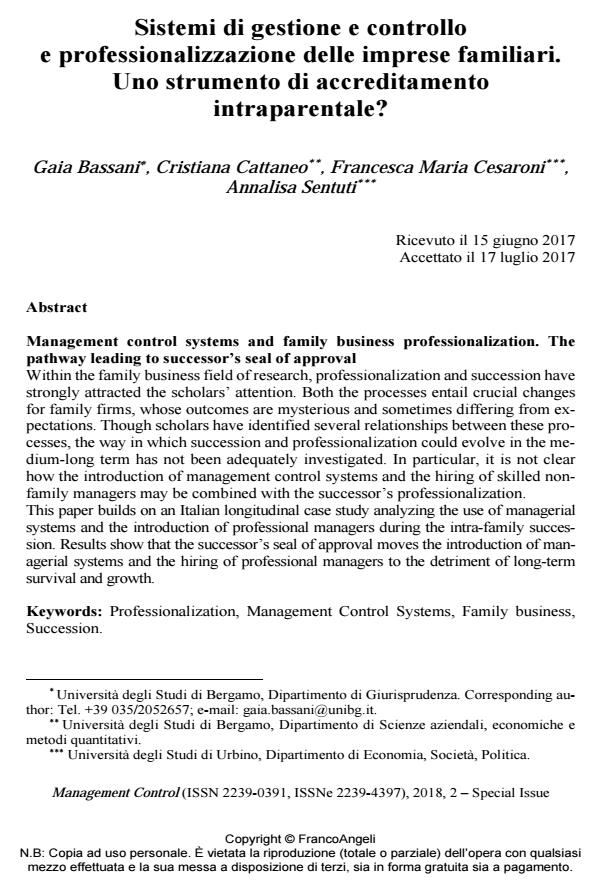Management control systems and family business professionalization. The pathway leading to successor’s seal of approval
Journal title MANAGEMENT CONTROL
Author/s Gaia Bassani, Cristiana Cattaneo, Francesca Maria Cesaroni, Annalisa Sentuti
Publishing Year 2018 Issue 2018/2 Suppl.
Language Italian Pages 21 P. 15-35 File size 231 KB
DOI 10.3280/MACO2018-SU2002
DOI is like a bar code for intellectual property: to have more infomation
click here
Below, you can see the article first page
If you want to buy this article in PDF format, you can do it, following the instructions to buy download credits

FrancoAngeli is member of Publishers International Linking Association, Inc (PILA), a not-for-profit association which run the CrossRef service enabling links to and from online scholarly content.
Within the family business field of research, professionalization and succession have strongly attracted the scholars’ attention. Both the processes entail crucial changes for family firms, whose outcomes are mysterious and sometimes differing from expectations. Though scholars have identified several relationships between these processes, the way in which succession and professionalization could evolve in the medium-long term has not been adequately investigated. In particular, it is not clear how the introduction of management control systems and the hiring of skilled non-family managers may be combined with the successor’s professionalization. This paper builds on an Italian longitudinal case study analyzing the use of managerial systems and the introduction of professional managers during the intra-family succession. Results show that the successor’s seal of approval moves the introduction of managerial systems and the hiring of professional managers to the detriment of long-term survival and growth.
Keywords: Professionalization, Management Control Systems, Family business, Succession
- High Performance Through Innovation Process Management in SMEs. Evidence from the Italian wine sector Simona Alfiero, Laura Broccardo, Massimo Cane, Alfredo Esposito, in MANAGEMENT CONTROL 3/2018 pp.87
DOI: 10.3280/MACO2018-003005 - Management Controlling and Governance of Family Businesses Annalisa Sentuti, Francesca M. Cesaroni, pp.51 (ISBN:978-3-030-47740-0)
- The national culture as a determinant of ERM quality: Empirical evidence in the European banking context Alessandra Allini, Raffaela Casciello, Marco Maffei, Martina Prisco, in MANAGEMENT CONTROL 1/2022 pp.79
DOI: 10.3280/MACO2022-001006
Gaia Bassani, Cristiana Cattaneo, Francesca Maria Cesaroni, Annalisa Sentuti, Sistemi di gestione e controllo e professionalizzazione delle imprese familiari. Uno strumento di accreditamento intraparentale? in "MANAGEMENT CONTROL" 2 Suppl./2018, pp 15-35, DOI: 10.3280/MACO2018-SU2002